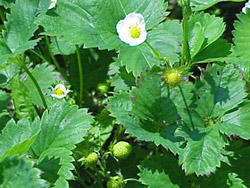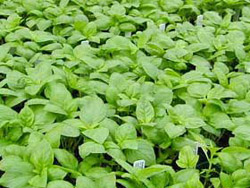Get Healthy and Save Money by Food Gardening
It's almost predictable: When economic times are hard, people head to the garden. It happened in the early 20th century with Liberty Gardens ... Read more »
Edible of the Month: Asparagus
It’s almost predictable: When economic times are hard, people head to the garden. It happened in the early 20th century with Liberty Gardens ... Read more »
How to: Build a Raised Bed
Raised beds are a great way to intensively garden without taking up too much space. They are perfect for urban small- space gardens, but also have advantages ... Read more »
Charlie says...
While the intention of this Edible Landscaping newsletter is to help people grow more food for themselves around their homes, I'd be remiss in not mentioning that it’s important to think of ... Read more »
March Q & A
Question: My strawberries are starting to flower but there’s frost forecast for my area. What should I do to protect them?

Answer: Strawberry flowers are particularly sensitive to freezing temperatures. Frost damages blooms by causing ice crystals to form, puncturing the plant cell walls and causing the cells to collapse. Commercial strawberry growers spray their fields with water to protect the blossoms. As the water freezes on the flowers, it gives off heat, keeping the temperature of the flower above freezing. However, this technique can get tricky because if temperatures are in the high 20ºFs, you’ll have to continue adding water and the weight of the ice may damage the plant.
For a home gardener it’s best to simply cover your strawberry plants before sunset with a heavy weighted, floating row cover. These floating row covers are designed to protect plants to 26ºF, while allowing air, light, and water to pass through them. They are worth the monetary investment. Remove the row covers once the temperature warms above freezing in the morning.
Question: I’m starting some basil seed indoors and they germinated fine. However, this morning I noticed many have flopped over and died. What happened?

Answer: It sounds like your basil got attacked by damping off fungal disease. This disease thrives with cool moist soil and poor air movement. It could be you overwatered the seedlings and this led to the disease getting established. Usually the seedlings rot at the soil line and the disease can spread quickly throughout the seedling tray.
The key to stopping this fungus is to act fast. Remove the diseased seedlings and any that look like they might be dying. Allow the soil to dry out by running a small fan over the seedling tray. This will dry out the soil and make the seedlings tougher. If in a few days your remaining seedlings aren’t growing well, consider starting over again. There’s still time to start another crop of basil indoors.
For more of this kind of information, we encourage you to subscribe to their newsletter!

No comments:
Post a Comment
Note: Only a member of this blog may post a comment.